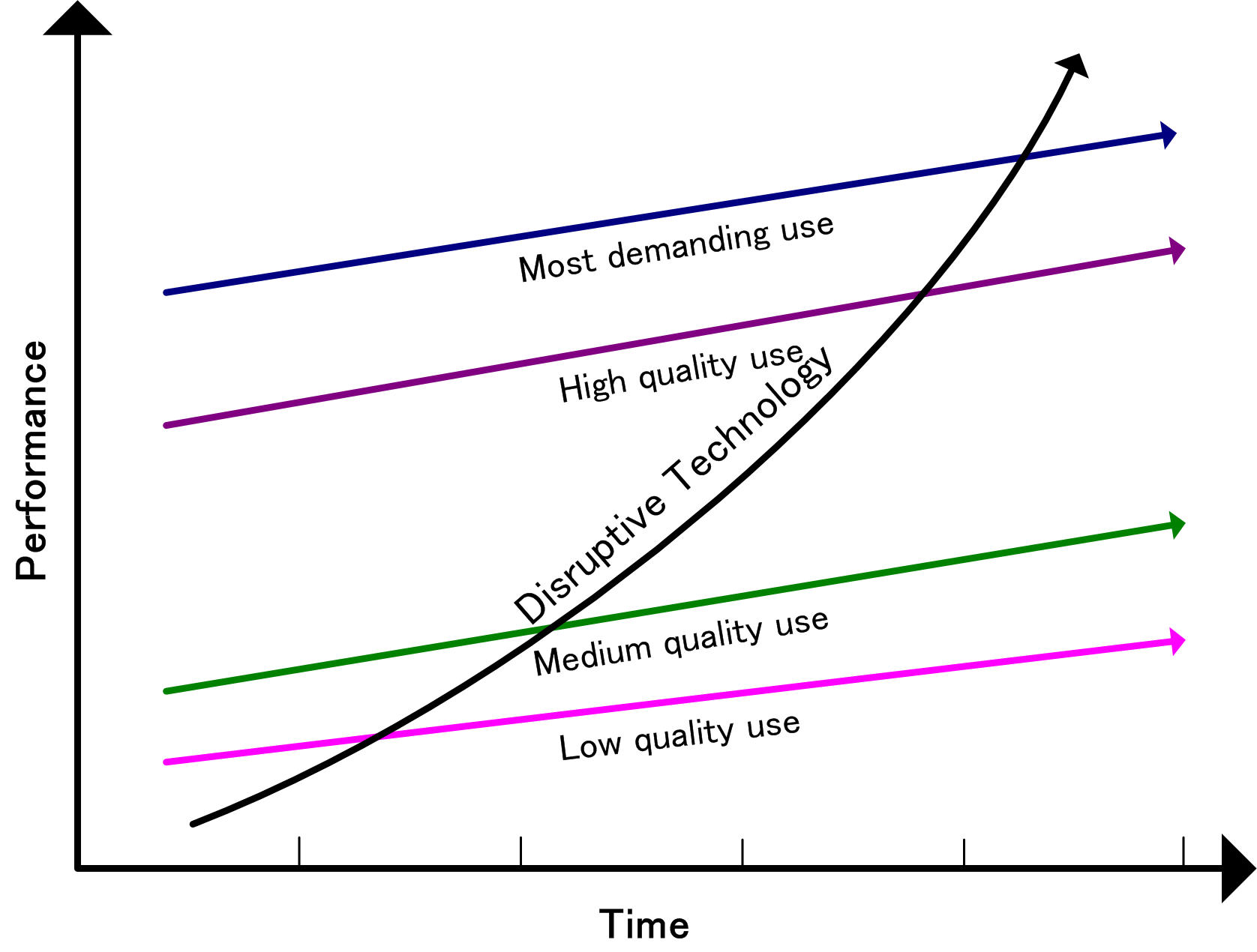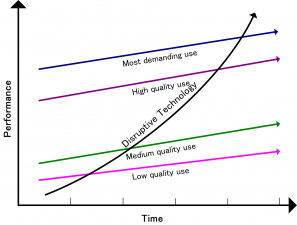When I did a search of the Display Daily website for the term ‘Disruptive’, there were 166 articles identified. However, looking through them, I had to go back to a Display Daily I wrote four years ago (Why Big Companies Can Struggle to Innovate) to see an article that used the term as defined by Clayton Christensen in his classic book, “The Innovator’s Dilemma’.

Check the article for a full description but, briefly, Christensen used the phrase to mean technologies that start off as low function and cheap, that don’t meet the needs of a current market. In particular, they don’t meet the needs of the high end of the market, which is often the most profitable part. However, the low price allows new applications which drive volume and technology until, eventually, the new technology gets enough functions for most users in the market and drives out the incumbent technology. Classic examples in technology are that mini-computers did it to mainframes and PCs did it to mini-computers.
 Disruptive Technology. Source:Wikipedia
Disruptive Technology. Source:Wikipedia
Another disruptive technology in the field was 3D graphics for games. This started off as being a very long way from what was needed for professional graphics. However, there are a lot of game players and they bought high volumes of GPUs for game play and eventually the volume and value of the market was enough to drive out the professional makers. For the last several years, the professional business has belonged to Nvidia and AMD, using hardware from the consumer devices, but with extra software certifications.
If a new technology doesn’t appear in this way, it may not be really disruptive. In the early days of LCD TV, I spoke to many companies that were confident that they could disrupt the TV business as it switched from CRTs to flat panels. However, there have been only a couple of brands that have managed to build successful businesses and major brands that had not been in the CRT TV business and those are Vizio and Xiaomi. Vizio did truly disrupt the business with its business model, but only made it work in the US. Xiaomi has yet to break into the TV market in a big way in the US or Europe, although it is getting stronger.
Now it’s possible that there has been a breakthrough in disruption. I’d like to be able to say it is in the display business, but not at the moment. microLED may have the potential to break through, as Barry Young wrote last week (Samsung Visual Display Division Forsakes QD-OLEDs in Favor of MiniLED TVs), but the jury is still out at the moment as to whether or when this will actually happen. The example I’m thinking of today is the M1 processor from Apple, which is based on the Arm architecture.
Apple is a Disruptor
I’ve been following the progress of Apple since I got my Apple ][ nearly 40 years ago and became the Chairman of the Apple User Group in the UK. (The Apple 2 was certainly a truly disruptive product). I stopped using their systems in the late 80s because of the need to understand the world of PCs for my work. The company has had good and even great products since, but hasn’t had a real performance edge in computing and power since the relatively early days of the Mac. In order to make the most of the scale of the PC architecture, the firm adopted Intel’s CPUs in 2006.
Meanwhile, Apple, of course, created the smartphone business with the iPhone. An iPhone is not a PC, it has much less functionality for many applications, but it was good enough for a lot of purposes and has become a ‘go to’ device for many functions that would previously have been the province of a PC. The Harvard Business Review recognises the iPhone as a classic disruptive technology because it was cheaper and simpler than a notebook as a way to access the internet.
The mobile phone market has huge scale (353 million last quarter vs 124 million for PCs, tablets and Chromebooks combined) and that has allowed tremendous progress in technology, including in the semiconductor manufacturing world. Apple has now taken the Arm architecture (about to be owned by Nvidia) that has been developed and adopted as the main smartphone processor architecture and combined it with its own technology and a supply chain that has huge scale. It has TSMC as a manufacturing partner, which has process technology that is more advanced than Intel has at the moment (5nm process) (although here I will admit to not being close to chip making and I have seen reports putting TSMC’s 5nm process as equivalent to Intel’s 7nm. Intel is currently at 10nm, but will not have 7nm until late 2022 or early 2023). Again TSMC’s growth and scale has been enabled by the huge volume of smartphone chips.
The M1 is Very Powerful
What does seem clear is that where the software has been optimised for the processor, the M1 chip that Apple announced a few weeks ago significantly beats Intel processors in performance, a new situation. The M1 architecture also has the memory integrated into the processor package itself. That makes it a lot faster as there is no separate graphics memory (I may return to that topic later). It does mean that, for the moment, that limits the RAM to 16GB. However, that may or may not be a challenge – more testing will reveal whether it is a genuine restriction.
 The Mac Mini has the connectivity for higher end applications
The Mac Mini has the connectivity for higher end applications
What’s intriguing is that this breakthrough has come from a giant. Typically, disruptive technology innovations come from start-ups and those outside the mainstream. It may be that Apple was able to make this move partly because it is not the incumbent in corporate computing. Typically, these disruptive technologies come in at lower prices than the incumbent technology. Hmmm, it wouldn’t be in keeping with the firm’s recent behaviour to see Apple bringing in low-priced products! (Although if the Mac Mini can offer workstation-like performance in some apps, it might be!). (BR)

